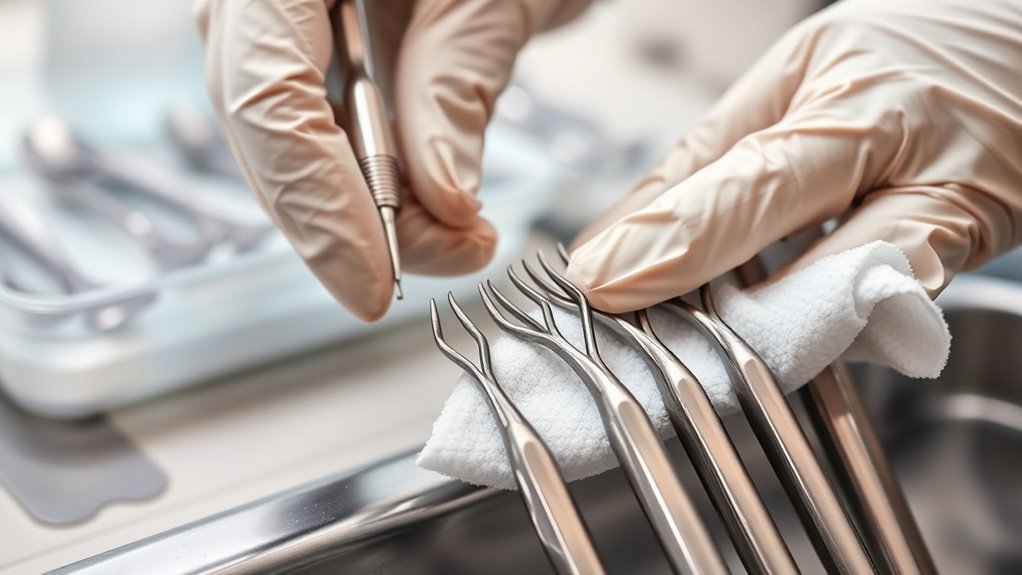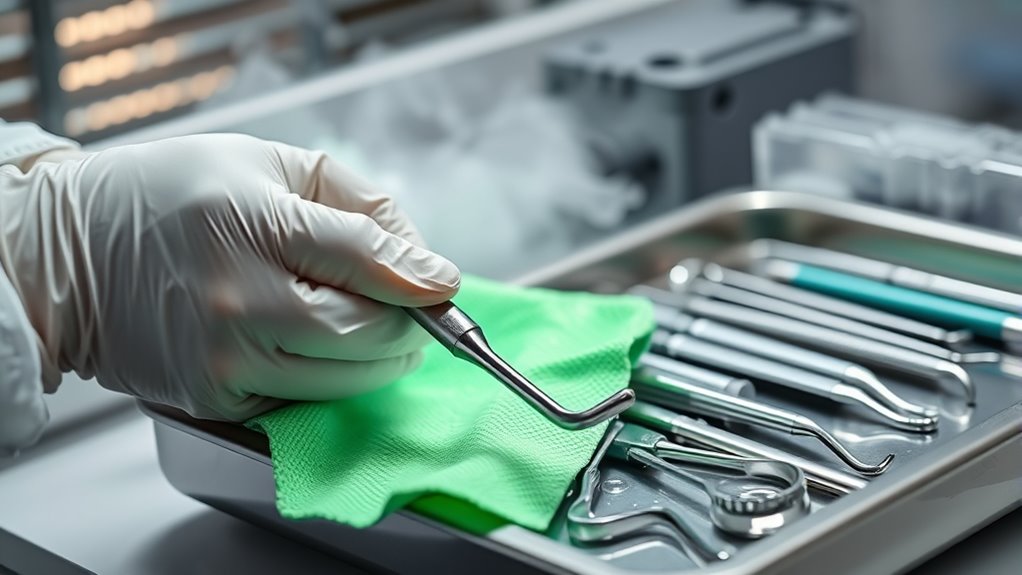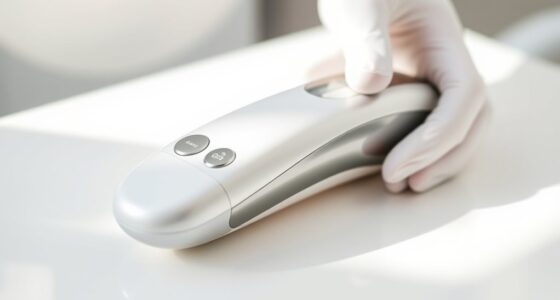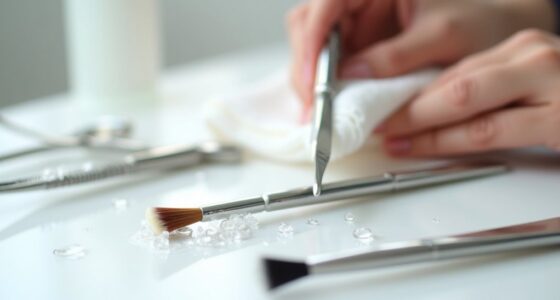Sanitizing your tools between uses is essential for preventing bacteria and viruses from spreading, which keeps clients and yourself safe. Proper cleaning and disinfection remove germs and reduce cross-contamination risks, ensuring a hygienic environment. Storing tools correctly and following recommended disinfection practices also help maintain their effectiveness. If you want to learn more about the best sanitation techniques and storage methods, continue exploring how to uphold the highest hygiene standards confidently.
Key Takeaways
- Sanitizing tools prevents the spread of germs and cross-contamination between clients.
- Proper sanitation maintains hygiene standards and reduces infection risks.
- It ensures tools remain effective and safe for each subsequent use.
- Regular cleaning and sanitizing protect both clients and practitioners from bacteria and viruses.
- Consistent sanitation reinforces overall health safety and professional hygiene practices.

Keeping your tools sanitized between uses is essential to guarantee the spread of germs and ensure safe, effective results. Proper storage methods play a crucial role in maintaining hygiene and preventing cross-contamination. After cleaning, store tools in a clean, dry container or designated area that minimizes exposure to dust, dirt, and airborne bacteria. Avoid leaving tools out in open spaces where they can pick up contaminants, and opt for airtight containers if possible. This not only preserves their cleanliness but also reduces the risk of accidental contact with unclean surfaces.
The effectiveness of disinfectants heavily depends on how you store and handle your tools. If disinfectants are not used correctly or if tools are not properly dried before storage, their ability to eliminate germs diminishes. Always follow the manufacturer’s instructions for dilution and contact time, making sure the disinfectant remains effective against a broad spectrum of bacteria and viruses. Applying a disinfectant and allowing it to sit for the recommended duration guarantees maximum germ-killing power. Moreover, using fresh disinfectant solutions rather than reused or expired ones enhances their effectiveness, giving you confidence that your tools are truly sanitized.
Proper storage methods also help maintain the integrity of your tools. For example, keeping sharp instruments in protective cases or sheaths prevents dulling or damage that can occur during exposure to other objects. It also helps contain any residual bacteria, preventing accidental contact with other surfaces or skin. Regularly cleaning storage areas and disinfecting containers ensures that bacteria don’t linger and contaminate your tools over time. When you organize your tools thoughtfully, you create a barrier that minimizes the chance of recontamination, reinforcing the importance of proper storage. Additionally, understanding the expiration dates of disinfectants and cleaning solutions can significantly impact their effectiveness and safety.
Frequently Asked Questions
How Often Should I Sanitize My Tools During Daily Use?
You should sanitize your tools after each use to maintain ideal tool longevity and prevent contamination. The sanitization frequency depends on how often you use them and the type of work involved. For daily use, it’s best to sanitize at least once after each session, especially if tools come into contact with different surfaces or materials. Regular sanitization ensures your tools stay in good condition and safe for continued use.
Can Improper Sanitization Damage My Tools?
Improper sanitization can damage your tools by causing tool corrosion and leaving residual bacteria that can weaken the material over time. If you don’t clean and dry your tools properly, moisture may build up, leading to rust and corrosion. Additionally, inadequate sanitization might leave bacteria that can cause deterioration or health hazards. Always follow proper cleaning procedures to safeguard your tools and ensure their longevity.
Are There Eco-Friendly Sanitizing Options Available?
Yes, eco-friendly sanitizing options are available. You can use biodegradable disinfectants that break down naturally without harming the environment. Reusable sanitizing wipes are also a great choice; they reduce waste and can be washed and reused multiple times. By choosing these options, you actively protect the planet while keeping your tools clean and safe. Switching to biodegradable disinfectants and reusable wipes makes your sanitization routine more sustainable and effective.
What’s the Best Method for Sanitizing Delicate Tools?
You should use gentle techniques to sanitize delicate tools, avoiding harsh chemicals that could damage them. Opt for chemical alternatives like alcohol wipes, diluted vinegar solutions, or steam sterilization, which are effective yet gentle. Always follow manufacturer instructions to prevent damage, and guarantee thorough coverage. Regularly sanitizing with these methods keeps your tools safe and clean, reducing the risk of infection while preserving their integrity.
How Do I Store Sanitized Tools to Maintain Cleanliness?
You store sanitized tools in a clean, dry container to maintain storage hygiene and prevent contamination. Ironically, it’s easy to forget that even the tiniest dust or moisture can undo your effort. Make sure the container is airtight and stored in a cool, dry place. Regularly clean your storage area to keep tools pristine, ensuring they stay safe and hygienic for every use.
Conclusion
By sanitizing your tools between uses, you considerably reduce the risk of bacteria and virus transmission, ensuring a safer environment. Think of it like a visual shield—each time you clean your tools, you’re creating a barrier that blocks harmful germs from spreading. Just as a windshield keeps debris out of your vision, proper sanitation keeps you and others protected. Don’t underestimate this simple step; it’s your first line of defense in maintaining health and safety.









